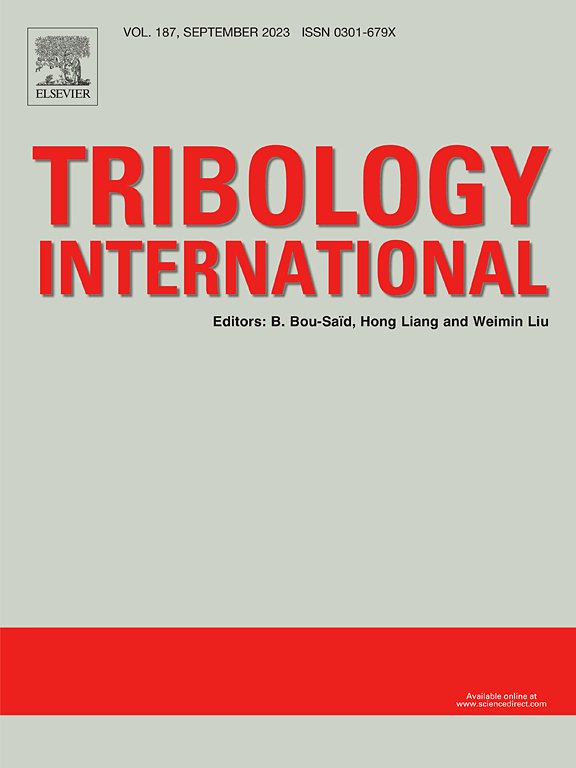Tribochemical mechanism of ionic liquid [P6,6,6,14][BEHP] on ferrous surfaces
IF 6.1
1区 工程技术
Q1 ENGINEERING, MECHANICAL
引用次数: 0
Abstract
The tribochemical reactions between [P6,6,6,14][BEHP] ionic liquid and ferrous surfaces are studied using reactive molecular simulations. The chemisorbed films initially develop through Fe−C, Fe−O, and Fe−P bonding, followed by decomposition of [P6,6,6,14][BEHP] generating free radicals, anions, and cations. Eventually, the cross-polymerization among [P6,6,6,14]+, [BEHP]- and their decomposition products leads to the tribofilm growth. The presence of base oil decreases the tribochemical reaction rate, it does not significantly alter the reaction pathways. And higher temperature significantly promotes tribochemical reactions rate, while the effect of normal stress is minimal and irregular. Furthermore, an electric field can direct reactive molecular species toward the substrate, thus, intensify the tribochemical reactions, and reduce the shear stress by improving the mobility of molecules. This work offers a comprehensive understanding of [P6,6,6,14][BEHP] tribofilm formation on ferrous interfaces.
离子液体[p6,6,14][BEHP]在亚铁表面的摩擦化学机理
采用反应分子模拟的方法研究了[p6,6,6,14][BEHP]离子液体与亚铁表面的摩擦化学反应。化学吸附膜最初通过Fe−C、Fe−O和Fe−P键形成,随后[P6,6,6,14][BEHP]分解生成自由基、阴离子和阳离子。最终,[p6,6,6,14]+、[BEHP]-及其分解产物之间的交叉聚合导致摩擦膜的生长。基础油的存在降低了摩擦化学反应速率,但对反应途径没有明显改变。温度升高可显著提高摩擦化学反应速率,而正应力对摩擦化学反应的影响较小且不规律。此外,电场可以将反应性分子引向底物,从而加强摩擦化学反应,并通过提高分子的迁移率来降低剪切应力。这项工作提供了对[P6,6,6,14][BEHP]在亚铁界面上形成摩擦膜的全面理解。
本文章由计算机程序翻译,如有差异,请以英文原文为准。
求助全文
约1分钟内获得全文
求助全文
来源期刊

Tribology International
工程技术-工程:机械
CiteScore
10.10
自引率
16.10%
发文量
627
审稿时长
35 days
期刊介绍:
Tribology is the science of rubbing surfaces and contributes to every facet of our everyday life, from live cell friction to engine lubrication and seismology. As such tribology is truly multidisciplinary and this extraordinary breadth of scientific interest is reflected in the scope of Tribology International.
Tribology International seeks to publish original research papers of the highest scientific quality to provide an archival resource for scientists from all backgrounds. Written contributions are invited reporting experimental and modelling studies both in established areas of tribology and emerging fields. Scientific topics include the physics or chemistry of tribo-surfaces, bio-tribology, surface engineering and materials, contact mechanics, nano-tribology, lubricants and hydrodynamic lubrication.
 求助内容:
求助内容: 应助结果提醒方式:
应助结果提醒方式:


